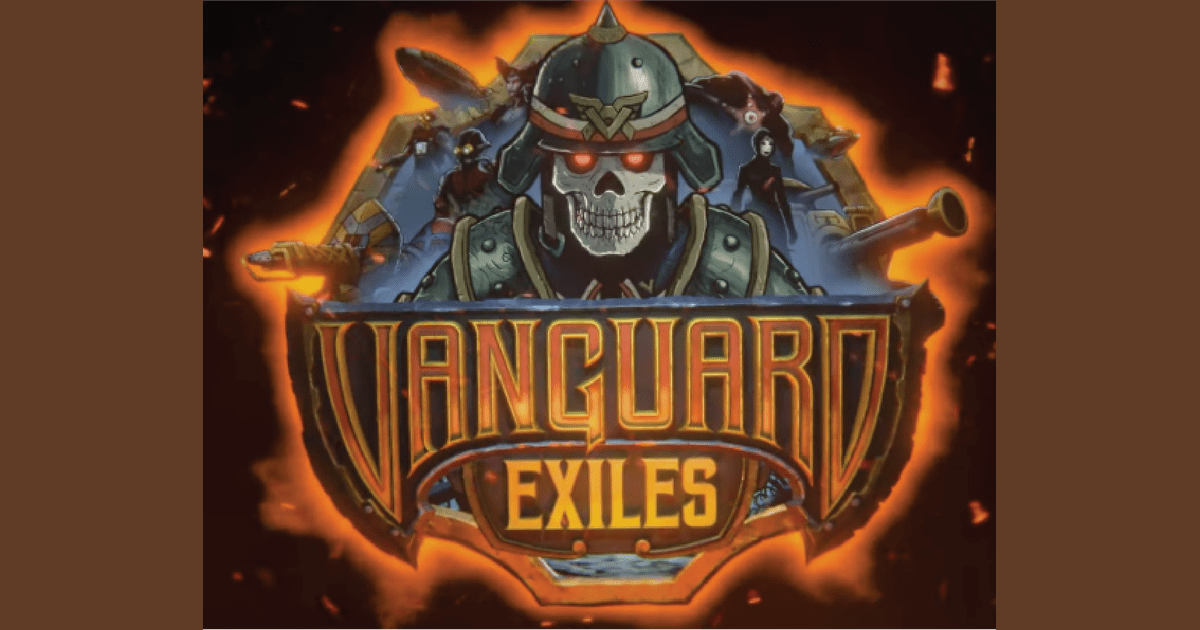SMOOSH JUICE
Designer Notes: Vanguard Exiles | BoardGameGeek News

Vanguard Exiles is a digital autobattler I have been working on for several years that has just entered early access on Steam. A number of elements might interest tabletop game players, so I thought I would share the story!
TL;DR: If you are interested in autobattlers, you can find a demo of Vanguard Exiles on Steam.
Autobattlers Are Amazing!
I have been interested in the design space between table games and digital games for a while. I remember playing Quake, finishing a session, then playing online Scrabble, and thinking how vast the space between these games was and what wondrous creations must live there. Designers have explored that territory in a slow and steady fashion, and these days with games like Slay the Spire and Balatro, the number of games that fit there is growing rapidly.
One genre that immediately piqued my interest was the autobattler, which became a genre with AutoChess. Now, depending on how you define the autobattler, it has been around a while. My definition is pretty broad: You make decisions, then there is an entertaining resolution. The resolution has to be complex enough to make it entertaining, so Rock Paper Scissors doesn’t fit.
By that definition, many tower-defense games are autobattlers, and some board games preceding AutoChess also qualify, including RoboRally and (a game that influenced RoboRally) Swashbuckler. A game like Magical Athlete has a whiff of autobattler as well since the races are usually more of a spectator event than something with interesting decisions; the decisions are generally more about which racers to get and when to race them.
The autobattler was kicked up a notch by Hearthstone Battlegrounds, and they have spread rapidly with excellent games such as Mechabellum and Once upon a Galaxy. The basic idea of all these games was “draft an army”, then “watch them fight”. Analog designers have attempted to bring this design entirely into the tablegame space with some success, like Challengers! My games along those lines haven’t been worth publishing; they are always fun, but I usually get the feeling “This would be more fun on a computer”, and I end up setting it aside.
My excursions into the digital space show more promise.
Bringing Board Game to Autobattler
What I wanted to explore in Vanguard Exiles was making the deployment of your army important. This was sometimes important in a game like Storybook Brawl or Hearthstone Battlegrounds, but the challenge was more frequently 90% about how you composed your army and 10% about what you did with them. To that end, I wanted to have a board, an exciting board with lots of interesting features that you placed your army on. When the deployment was done, your army would capture territory, wander around, and, of course, battle.
We settled on having a dungeon-like map set on a hex grid. We would distribute rooms that would give a variety of victory points, gold, and other effects, like buffing your creatures or giving you extra units in future battles.
This method deployment and battle has led to a game in which, maybe, it is 30% about your deck and 70% how you deploy.
Above you can see a typical map at the start of a game. There are four rooms worth 4, 3, 2, and 1 VP, as well as a corridor. I have three units to deploy. I could put them all in the most valuable room, and I would likely get that — but if my opponent spreads out, they will get more VP.
So maybe I put no units in that room and spread out in the others, but then my opponent could take that room with a single unit, and if they double up in one of the rooms, I will (once again) lose. Of course, there are no right answers — just some better and worse ones (going all-in on the single point room is not so good), and every move can be outplayed if you are psychic.
This isn’t even getting into the differences between the units. The ranger I have can attack at a range of 1, so players will often deploy them in corridors, where they can’t immediately capture but they can attack into neighboring rooms. Also, I have a unit with armor — my nail, which is unlikely to defeat anything by itself but can do a pretty good job at holding a room until the rest of the army gets there.
Once you have deployed, units battle, take control of rooms, then move to fight more enemies and capture more rooms.
Here you can see a midgame map; each round, rooms are added and sometimes they get removed. This map has evolved into two separate sections that are pretty close in value to one another. Dangerous mined rooms in both sections have a chance of damaging units that are there. There is also a room that gives gold in the lower section, which can be used to buy better troops.
Variety versus Character
We decided to use unique decks as I did in KeyForge. What I was looking for was varied play with lots of different cards and a system that could be ever expanding. If you let people construct their own decks within this framework, you are taking a chunk of the content and relegating it to the bin if it is not deemed up to snuff. Unfortunately, that chunk is often the most fun stuff because fun doesn’t necessarily win games. It is a choice I don’t like to make: getting rid of cards that are fun but not competitive enough…
Placing all of the cards in a common deck, as is usually done, doesn’t give the distinct character between decks that I was after. and this choice makes it hard to expand the game design. As you expand, your deck becomes bigger and bigger — diluting the impact of the new stuff — or you have to remove some old stuff, which decreases potential variety.
By giving random decks to each player, you have to play the good with the bad and deal with your deck’s strengths and weaknesses as they are revealed. It is not clear what the best way to swap between decks is. If you are committed too long to a deck, you will be frustrated by wanting to play something new — but if players get a new deck every play, they won’t learn the strengths and weaknesses, that is, the character of the deck to any depth. The ideal will differ for different people, but some pressure to adapt to the deck, along with some access to new decks, will be what we are after.
Analysis
One thing I enjoyed in working on this was using tools to determine how the skirmishes could have gone. These allowed us to better balance the units and give us insight into what was expected behavior. These tools were so much fun to play with that we included them in the game; now you can analyze any battle to see what the expected outcome was. Did you get lucky? Unlucky? You can find the answers there.
Above, you can see an example: I was playing blue, and I felt I got pretty unlucky with my 2 points out of a possible 11. I checked the statistics, and sure enough I was expected to get 6 points! But you can also see that getting 2 was not that unlikely. Later in the game, the charts can get pretty crazy with surprising results!
We might try to incorporate these statistics into play, at least as a variant. Naturally some folks have asked for a mode in which the median result is always used. I think this would be less fun, but am happy to try it. Another possibility that I would love to try is giving people a certain number of re-rolls for the game. This could be quite skill testing because you will want to use your re-rolls on battles that are most skewed against you — and just recognizing those can be a challenge.
Another way this might be used, a way with a marvelous flavor, is that maybe some sort of fairy unit gives you good luck. When you use it, two battles are generated, and the better result is used!
Unit Design
The fun part of development is upon us, and many ideas are floating around for cool new units. Here are a few that have piqued my interest recently:
• The Hall Hound: With flavor inspired by H.P. Lovecraft’s “Hounds of Tindalos”, these can be deployed only in corridors and can move directly from one corridor to another as if they were connected. These can be pretty buff because they cannot capture rooms, but they will help prevent the opponent from moving around and capturing multiple rooms — and they will shut down archers hiding out in the hallways.
• The Cairn Monkey: The cairns are rooms that buff the capturing units permanently. Naturally they are highly contested! The Cairn Monkey has a bonus attack in these rooms and will cause them to trigger twice.
• The Ghoul Queen: Each time a unit dies in the Ghoul Queen’s room, the Ghoul Queen gains stats and is fully healed — but is also stunned for a turn (while she devours the victim).
• The Bone Mechanic: He comes into play with a number of Skeleton Knights. Want more? Don’t deploy him in a battle, and he will learn to bring an additional Skeleton Knight when deployed.
Flavor
I often prototype in a fantasy theme, generally as a placeholder; I find it flexible and broad and it helps communicate mechanisms easily. Vanguard was made in this way, and when we brainstormed what we wanted to do with the final flavor, there were a lot of concepts punted around, and one that quickly gained traction was our art director Wes’ idea for a fantasy WWI style setting. This maintained the strengths of fantasy without feeling stale as the style was distinctive. The atmosphere also resonated with the idea that these maps were dungeons; now they became dungeons set inside a vast, labyrinthine network of trenches.
My favorite part of this dieselpunk flavor is the elves. They have all these radiation-themed powers so they are sort of a early 1900s science collective, with actions like Radiation Therapy (permanently buffs a unit) and units like Gamma Priest, Agent of Decay, and Kin of the Atom. It feels dark, and it feels right…
Early Access
As I mentioned above, Vanguard Exiles is in early access. There is still a long way to go, but I am quite happy with what is there. We do not yet have a single-player campaign or a good tutorial, but there is play against the AI with various difficulties, and there is multiplayer play, with a friendly Discord group that discusses strategy and development possibilities. The demo should be plenty to figure out if you like where we are headed, and if you are inclined to multiplayer, you will probably like the early access. For folks who are more interested in single player, just get the demo for now. If you love it, there will be additional cards soon in the early access — but you can also wait until we actually have a more complete solo campaign.

/pic8781420.png)
/pic8781413.png)
/pic8781462.png)
/pic8781415.png)
/pic8781580.png)